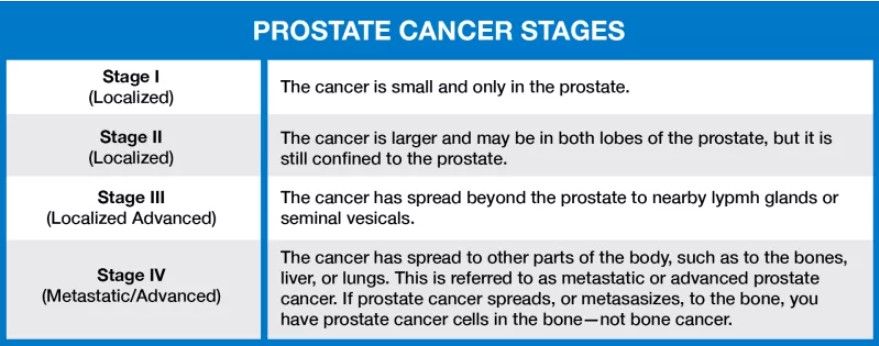Prostate cancer basics
Prostate cancer is the most commonly diagnosed cancer in men after skin cancer. When caught early, the 5-year survival rate is nearly 100 percent.
Prostate cancer risk factors
The greatest risk factors for getting prostate cancer are age, family history, and race. Other risk factors include diet and exposure to chemicals.
If you don’t have these risk factors, that doesn’t mean you can’t get prostate cancer. Remember, all men are at risk for prostate cancer
- Age
- The risk of prostate cancer grows significantly as men age. About 60% of all prostate cancers are diagnosed in men over 65.
- Family History
- Risk for prostate cancer can run in families. A man with at least one close relative who has had prostate cancer is twice as likely to be diagnosed with the disease compared to the general population. It is estimated that inherited gene changes – those passed down by parents – account for approximately 10% of prostate cancers. Learn more about genes, genetic testing, and prostate cancer. Talk with everyone in your family about their health history and download and complete ZERO’s prostate cancer family tree.
- Race
- Black and African American men are more likely to get prostate cancer than other men. In fact, Black men are 1.7 times more likely to get prostate cancer and 2.1 times more likely to die from the disease than white men. Black men in the U.S. and Caribbean have the highest prostate cancer incidence rates in the world.
- Veterans & chemical exposure
- Exposure to chemicals can add to prostate cancer risk and severity. Studies have shown Vietnam and Korean War Veterans with exposure to chemicals like Agent Orange have a higher occurrence of prostate cancer. Veterans are about twice as likely to be diagnosed with prostate cancer than men who have never served in the military. Prostate cancer is the most common malignancy in Veterans, diagnosed in approximately 11,000 men in the VA system each year. Veterans with prostate cancer who were exposed to herbicides during active service may be eligible for disability compensation through the Department of Veterans Affairs (VA). Learn more about support resources for Veterans, including VA benefits. Others at increased risk due to chemical exposure include:
- Farmers and other men who work with large amounts of pesticides
- Those who are frequently exposed to the metal cadmium like welders, battery manufacturers, and rubber workers
- There is some evidence that firefighters are at higher risk.
- Exposure to chemicals can add to prostate cancer risk and severity. Studies have shown Vietnam and Korean War Veterans with exposure to chemicals like Agent Orange have a higher occurrence of prostate cancer. Veterans are about twice as likely to be diagnosed with prostate cancer than men who have never served in the military. Prostate cancer is the most common malignancy in Veterans, diagnosed in approximately 11,000 men in the VA system each year. Veterans with prostate cancer who were exposed to herbicides during active service may be eligible for disability compensation through the Department of Veterans Affairs (VA). Learn more about support resources for Veterans, including VA benefits. Others at increased risk due to chemical exposure include:
- Diet & physical activity
- Obesity may be associated with a slight increase in the risk of getting prostate cancer. Being obese and overweight may be related to prostate cancer aggressiveness and development according to a handful of studies. Obesity may increase the long-term disease progression for men with low-risk prostate cancer who are on active surveillance. Regular physical activity has a positive impact on health and prostate cancer. Men who walk one to three hours each week have an 86% lower risk of aggressive prostate cancer. Further research has demonstrated three or more hours of vigorous exercise lowered the risk of prostate cancer death by 61%. To learn more about actionable steps you can take related to health, wellness, and nutrition visit our Health & Wellness in Prostate Cancer webpage.
Treating prostate cancer
Prostate cancer is a treatable disease, though not all cases require immediate treatment. Staging will help decide which treatment options may be right for you.
Staging is the process used to find out more about the location of the cancer and if it has spread within the prostate or to other parts of the body.
Knowing the stage of your prostate cancer is very important. It can help you accurately talk about your prostate cancer and discuss treatment options with your medical team. The process of staging involves a biopsy of the prostate cells, as well as imaging scans like ultrasound, MRI scans, and CT scans.
You may hear or see different terms for prostate cancer stages.
- Stages I and II are also known as localized prostate cancer or early-stage prostate cancer.
- Stage III is also known as locally advanced prostate cancer.
- Stage IV is also known as metastatic prostate cancer or advanced prostate cancer.

Facts About Prostate Cancer
- Prostate cancer is one of the most common cancers among men
- This year, more than 160,000 men will be told they have prostate cancer
- Some men are at higher risk for prostate cancer. Aside from age, risk factors for prostate cancer include family history and race
- 1 in 5 African American men will develop prostate cancer
- 1 in 3 men with a family history will develop prostate cancer
- Nearly 3 million men in the U.S. count themselves as prostate cancer survivors